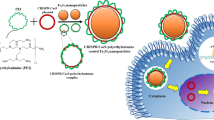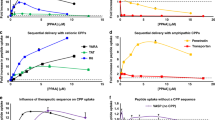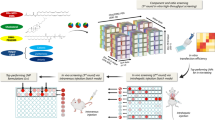Abstract
We recently reported a novel coupling strategy involving salicylhydroxamic acid and phenyl(di)boronic acid molecules to attach the CNGRC peptide to PEI/DNA for CD13 targeting in tumors. Here, we doubly coupled Simian Virus (SV) 40 peptide-(nuclear localization signal)) and oligonucleotide-based (DNA nuclear targeting signal) nuclear signals to the same vector using peptide nucleic acid chemistry. This vector, CNGRC/PEG/PEI/DNA-βgal/NLS/DNTS, was predominantly localized in the cell nucleus, yielding about 200-fold higher βgal gene expression in vitro, more than 20-fold increase in tumor-specific gene delivery, and a robust βgal gene expression as demonstrated in stained tumor sections. For gene therapy purposes, we further engineered a similar targeting polyplex, CNGRC/PEG/PEI/DNA-p53/NLS/DNTS, with EBV-based episomal vector for sustained p53 gene expression. A distribution of vector DNA and apoptosis in p53-containing tumors was observed, yielding a significant tumor regression and 95% animal survival after 60 days. This multicomponent vector also co-targeted tumor and tumor-associated endothelial cells but not normal cells, and had more efficient therapeutic index than each vector administered as a single modality. The use of an efficient coupling strategy without compromising the vector's integrity for DNA condensation and endosomal escape; nuclear import; tumor-specific and persistent p53 gene expression clearly provides a basis for developing a single combinatorial approach for non-viral gene therapy.
This is a preview of subscription content, access via your institution
Access options
Subscribe to this journal
Receive 12 print issues and online access
$259.00 per year
only $21.58 per issue
Buy this article
- Purchase on Springer Link
- Instant access to full article PDF
Prices may be subject to local taxes which are calculated during checkout







Similar content being viewed by others
References
Sweeney P, Karashima T, Ishikura H, Wiehle S, Yamashita M, Benedict W et al. Efficient therapeutic gene delivery after systemic administration of a novel polyethylenimine/DNA vector in an orthotopic bladder cancer model. Cancer Res 2003; 63: 4017–4020.
Moffatt S, Wiehle S, Cristiano RJ . Tumor-specific gene delivery mediated by a novel peptide/polyethylenimene/DNA polyplex targeting aminopeptidase N (CD13). Hum Gene Ther 2005; 16: 57–67.
Wu CH, Wilson JM, Wu GY . Targeting genes: delivery and persistent expression of a foreign gene driven by mammalian regulatory elements in vivo. J Biol Chem 1989; 264: 16985–16987.
Branden LJ, Mohamed AJ, Smith CIE . A peptide nucleic acid nuclear localization signal fusion that mediates nuclear transport of DNA. Nat Biotechnol 1999; 17: 784–7871.
Chan CK, Jans DA . Enhancement of polylysine-mediated transfer infection by nuclear localization sequences: polylysine does not function as a nuclear localization sequence. Hum Gene Ther 1999; 10: 1695–1702.
Zanta MA, Belguise-Valladier P, Behr JP . Gene delivery: a single nuclear localization signal peptide is sufficient to carry DNA to the cell nucleus. Proc Natl Acad Sci USA 1999; 96: 91–96.
Colin M, Maurice M, Trugnan G, Kornprobst M, Harbottle RP, Knight A et al. Cell delivery, intracellular trafficking and expression of an integrin-mediated gene transfer vector in tracheal epithelial cells. Gene Therapy 2000; 7: 139–152.
James MB, Giorgio TD . Nuclear-associated plasmid, but not cell-associated plasmid, is correlated with transgene expression in cultured mammalian cell. Mol Ther 2000; 1: 339–346.
Collas P, Alestrom P . Rapid targeting of plasmid DNA to zebrafish embryo nuclei by the nuclear localization signal of SV 40T antigen. Mol Marine Biol Biotechnol 1997; 6: 48–58.
Dean DA . Import of plasmid into the nucleus is sequence specific. Exp Cell Res 1997; 230: 293–302.
Escriou V, Ciolina C, Helbling-Leclerc A, Wils P, Scherman D . Cationic lipid-mediated gene transfer uptake and nuclear import of plasmid DNA. Cell Biol Toxicol 1998; 14: 95–104.
Pollard H, Remy JS, Loussouarn G, Demolombe S, Behr JP, Escande D et al. Polyethylenimine but not cationic lipids promotes transgene delivery to the nucleus in mammalian cells. J Biol Chem 1998; 27: 7507–7511.
Dean DA, Byrd JN, Dean BS . Nuclear targeting of plasmid DNA in human corneal cells. Cell Biol Toxicol 1999; 19: 66–75.
Neves C, Escriou V, Byk G, Scherman D, Wils P . Intracellular fate and nuclear targeting of plasmid DNA. Cell Biol Toxicol 1999; 15: 193–202.
Hagstrom JE, Ludtke JJ, Bassik MC, Sebestyen MG, Adam SA, Wolff JA . Nuclear import of DNA in digitonin-permeabilized cells. J Cell Sci 1997; 110: 2323–2331.
Hartig R, Shoeman RL, Janetzko A, Grub S, Traub P . Active nuclear import of single-stranded oligonucleotides and their complexes with non-karyophilic macromolecules. Biol Cell 1998; 90: 407–426.
Sebestyen MG, Ludtke JJ, Bassik MC, Zhang G, Budker V, Lukhtanov EA et al. DNA vector chemistry: the covalent attachment of signal peptide to plasmid DNA. Nat Biotechnol 1998; 16: 80–85.
Vacik J, Dean BS, Zimmer WE, Dean DA . Cell-specific nuclear import of plasmid DNA. Gene Therapy 1999; 6: 1006–1014.
Brown MD, Schatzlein AG, Uchegbu IF . Gene delivery with synthetic (non-viral) carriers. Int J Pharm 2001; 229: 1–21.
Bremner KH, Seymour LW, Logan A, Read ML . Factors influencing the ability of nuclear localization sequence peptides to enhance non-viral gene delivery. Bioconjugate Chem 2004; 15: 152–161.
Ludtke JJ, Zhang G, Sebestyen MG, Wolff JA . A nuclear localization signal can enhance both the nuclear transport and expression of 1 Kb DNA. J Cell Sci 2003; 112: 2033–2041.
Kalderon D, Richardson WD, Markham AF, Smith AE . Sequence requirements for nuclear location of simian virus 40 large-T antigen. Nature 1984; 311: 33–38.
Tanimoto M, Kamiya N, Matsuda A . No enhancement of nuclear entry by direct conjugation of a nuclear localization signal peptide to linearized DNA. Bioconjugate Chem 2003; 14: 1197–1202.
Nielsen PE, Egholm M, Berg RH, Buchardt O . Sequence-selective recognition of DNA by strand displacement with a thymine-substituted polyamide. Science 2001; 254: 1497–1500.
Egholm M, Buchardt O, Christensen L, Behrens C, Freier SM, Driver DA et al. PNA hybridizes to complementary oligonucleotides obeying the Watson–Crick hydrogen-binding rules. Nature 1993; 365: 566–568.
Haahr-Hansen MH, Sode LL, Hyldig-Nielsen JJ, Engberg J . Detection of PNA/DNA hybrid molecules by antibody Fab fragments isolated from a phage display library. J Immunol Methods 1997; 203: 199–207.
Misra HS, Pandey PK, Modak MJ, Vinayak R, Pandey VN . Polyamide nucleic acid-DNA chimera lacking the phosphate backbone are novel primers for polymerase reaction catalyzed by DNA polymerases. Biochemistry 1998; 37: 1917–1925.
Gambari R . Peptide nucleic acids: a tool for the development of gene expression modifiers. Curr Pharm Des 1991; 7: 1839–1862.
Roulon T, Helene C, Escude C . Coupling of a targeting peptide to plasmid DNA using a new type of padlock oligonucleotide. Bioconjugate Chem 2002; 13: 1134–1139.
Gottschalk S, Cristiano RJ, Smith L, Woo SLC . Folate receptor-mediated gene delivery into tumor cells: potosomal disruption results in enhanced gene expression. Gene Therapy 1994; 1: 185–191.
Wagner E, Zenke M, Cotton M, Beug H, Birnstiel ML . Transferrin-polycation conjugates as carriers for DNA uptake into cells. Proc Natl Acad Sci USA 1990; 87: 3410–3414.
Young JL, Benoit JN, Dean DA . Effect of DNA nuclear targeting sequence on gene transfer and expression of plasmids in the intact vasculature. Gene Therapy 2003; 10: 1465–1470.
Abdallah B, Hassan A, Benoist C, Goula D, Behr JP, Demeneix BA . A powerful non viral vector for in vivo gene transfer into the adult mammalian brain: polyethylenmine. Hum Gene Ther 1996; 7: 1947–1954.
Arap W, Pasqualini R, Ruoslahti E . Cancer treatment by targeted delivery to tumor vasculature in a mouse model. Science 1998; 279: 377–380.
Pasqualini R, Koivunen E, Kain R, Lahdenranta J, Sakamoto M, Stryhn A et al. Aminopeptidase N is a receptor for tumor-specific peptides and a target for inhibiting angiogenesis. Cancer Res 2000; 60: 722–727.
Ellerby HM, Arap W, Ellerby M, Kain R, Andrusiak R, Rio GD et al. Anti-cancer activities of targeted pro-apoptotic peptides. Nat Med 1999; 5: 1032–1038.
Boussif O, Lezoualc'h F, Zanta MA, Mergny MD, Scherman D, Demeneix B et al. A versatile vector for gene and oligonucleotide transfer into cells in culture and in vivo: polyethylenimine. Proc Natl Acad Sci USA 1995; 92: 7297–7301.
Keller M, Harbottle RP, Perouzel E, Colin M, Shah I, Rahim A et al. Nuclear localization sequence templated non-viral gene delivery vectors: investigation of intracellular trafficking events of LMD and LD vector systems. Chem Biochem 2003; 4: 286–298.
Ferkol T, Pellicena-Palle A, Eckman E, Perales JC, Trzaska T, Tosi M et al. Immunologic responses of gene transfer into mice via the polymeric immunoglobulin receptor. Gene Therapy 1996; 3: 669–678.
Mulligan RC . The basic science of gene therapy. Science 1993; 260: 926–932.
Kozarsky JF, Wilson JM . Gene therapy: adenovirus vectors. Curr Opin Genet Dev 1993; 3: 499–503.
Jiao S, Williams P, Berg RG, Hodgeman BA, Liu L, Repetto G et al. Direct gene transfer into nonhuman primate myofibers in vivo. Hum Gene Ther 1992; 3: 21–33.
Krygier S, Djakiew D . Neurotrophin receptor p75(NTR) suppresses growth and nerve growth factor-mediated metastasis of human prostate cancer cells. Int J Cancer 2002; 98: 1–7.
Acknowledgements
We are grateful to Dr Randall Evans (Department of Molecular Hematology and Therapy) of the Flow Cytometry/Cell Sorting and Confocal Microscope/Image Analysis Core of the University of Texas MD Anderson Cancer Center for his invaluable technical assistance in confocal microscopy. This work was supported in part by NIH grant #5P30CA016672–29 supporting the core facility.
Author information
Authors and Affiliations
Corresponding author
Rights and permissions
About this article
Cite this article
Moffatt, S., Wiehle, S. & Cristiano, R. A multifunctional PEI-based cationic polyplex for enhanced systemic p53-mediated gene therapy. Gene Ther 13, 1512–1523 (2006). https://doi.org/10.1038/sj.gt.3302773
Received:
Revised:
Accepted:
Published:
Issue Date:
DOI: https://doi.org/10.1038/sj.gt.3302773
Keywords
This article is cited by
-
Importance of buffering nanolayer position in Layer-by-Layer assembly on titania based hybrid photoactivity
Journal of Sol-Gel Science and Technology (2019)
-
Comparison of Caspase Genes for the Induction of Apoptosis Following Gene Delivery
Molecular Biotechnology (2009)
-
Gene therapy progress and prospects: synthetic polymer-based systems
Gene Therapy (2008)
-
Cell and Tissue Targeting of Nucleic Acids for Cancer Gene Therapy
Pharmaceutical Research (2007)
-
The concept of molecular machinery is useful for design of stimuli-responsive gene delivery systems in the mammalian cell
Journal of Inclusion Phenomena and Macrocyclic Chemistry (2007)



